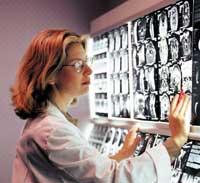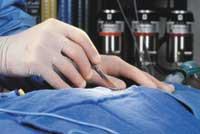Our health in the hands of computers and robots
2001/01/01 Mendiburu, Joana - Elhuyar Zientziaren Komunikazioa Iturria: Elhuyar aldizkaria
Today, the development of technological research is something that is known and is not thought to later not affect medicine. Engineers and doctors work tirelessly to create new working techniques and robots.
The European Commission notes that in 2002 robotics will involve 800,000 interventions.
Telequirurgia, revolution in operating theatres
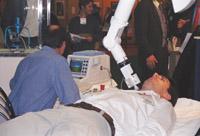
The contributions of new technologies in medicine in recent years are not negligible. Microtechnological, endoscopic and computer unification has revolutionized operating theatre techniques.
For some operations it is no longer necessary to make an incision of 10-15 centimeters, just a few small incisions. By this hole, surgeons insert long tubes of 1.8 to 10 millimeters in diameter to the site of the intervention. From one of these tubes, carbon dioxide is absorbed so that the surgeon has more room to work. At the opposite end, a microcamera and surgical tools. The images taken by the microcamera appear on a screen that allows the doctor to drive his movements. As in video games, the surgeon works with scissors.
This new operative technique presents numerous advantages for both the doctor and the patient. In the images of the camera, the surgeon has a more complete picture of the body part in view, allowing you to work more accurately. The patient has also benefited from a number of benefits, as having a smaller cut the recovery is less painful. Along with avoiding postoperative blood transfusion, it ensures lighter anesthesia and easier scar.
Thanks to computer science, the surgeon operated never feels alone. In fact, in the so-called telequirurgia, the images taken by the microcamera can be seen outside the operating room if they are connected by computer. In this way, if during the intervention the surgeon has any doubt, you can ask another expert for advice at the same time. This is the interactive operation that has had so much impact.
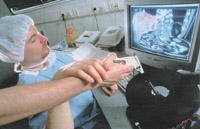
In addition to exchanging information with remote control robots, there is the possibility of intervening in the operation outside the operating room. Although it is not yet a widely used technique, for example, in the sutures of small arteries. This intervention requires great precision and may require the intervention of the surgeon in the realization of concrete and forceful interventions. However, according to experts, it would be too dangerous for any operation to be performed by doctors in the other part of the world. Cutting the light force would be enough to endanger the patient's life. This technique will be used for the realization of certain works that require great precision.
Previous operation
One of the current objectives of the researchers and surgeons is that the intervention contacts can be prepared before the opening of the patient. Although until now it seemed impossible, investigations into liver operation are very advanced.
Thanks to a computer program, the liver images taken by a scanner can go into three dimensions. The program is so complex that the computer needs half an hour to do its job. Complex but also effective, it detects small tumors of 3 millimeters.
The surgeon then cuts the part that has virtually detected the tumor. Mark three points on the liver and the computer shows the consequences of this ablation. Thus, the surgeon decides to perform this or another extraction.
With the same idea they want to create for 2006 a roboscope robot that can be programmed previously. Here you can also see on the screen the image of the organ that will be intervened thanks to the scanner. Because Roboscope will be connected to the computer, the surgeon will operate as if it were on the organ in the screen image. This will identify work directions and schedule the robot arm not to move in those directions. In addition, the articulated arm moves without any difficulty by the surgeon, but mechanically it is limited to avoid sudden movements by surprise. It therefore guarantees maximum security.
On the other hand, anticipation of the intervention will also serve to train students. They can repeat the movements as many times as they want to achieve maximum confidence and effectiveness. From a medical point of view, doctors agree that these types of devices are essential for a specific movement.
Robot Pointers
The goal of robotics is not to replace the doctor, but to facilitate and improve his work. It is intended to ensure greater safety by avoiding possible unforeseen or poor work when the doctor is tired or nervous.
The Aescop robot, made in 1999, was named "third hand of the surgeon". This robot is a long arm with a joint and its "hand" is the indispensable microcamera in operations. Although it looks like one of the long arms that have been seen on several occasions, it has a great novelty: the surgeon gives the orders verbally. According to Jacques Marescaux, founder of the European Teleassistance Institute, "it is very important that during the four or six hours of operation, no one should remain on camera. In addition to being a boring job, fatigue vibrates in the man's arm, and after a few hours there are not very clear images." To drive the Aescop robot, previously the surgeon must record "light on", "lower", "right" and 23 orders of this type.
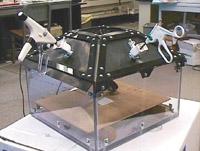
Not all robots that are designed will be used in surgical interventions. For example, the Hippocrate robot that is being developed in the French company SINTER, will be used for the prevention of cardiovascular diseases. It consists of a long arm guided by a computer. The "hand" of this arm is the probe used to perform the ultrasound. J. According to Gariepy, "although ultrasound is currently widely used, the small movements of the ultrasound make it impossible to monitor the arteries thoroughly." This robot allows blood pressure control during ultrasound. In this way, the pressure needed to pass the ultrasound signal is achieved, but without deforming the artery. To keep track of time it is necessary to always work with the same pressure. It is intended to avoid sterosclerosis, that is, the appearance of plaques in the arteries. J. Dr. Gariepy stressed that "the image of the plates that appear on the screen can pass in three dimensions, which greatly facilitates the detection of the plates".
M. Laboratory Lirm de Montpelier The engineer of Dombre is the designer of the robot Dermarob. This robot will be used to take skin from any part of the body, mainly to repair burned areas and perform orthopedic operations. The depth of the bark sample is usually several millimeters and should be as regular as possible to preserve the aesthetic.
For the doctor this work is very complicated and laborious since you have to press with a force of about ten kilos. In addition, for example, taking the skin from the headboard does not always work in comfortable positions. Moreover, this movement requires great knowledge and experience and it is necessary to perform operations without interrupting the loss of skill. In the case of orthopedics, for example, this is impossible since such operations are not usually done.
For the moment the mechanical and electrical side of the project has been carried out and during 2001 experiences with the corpses will be carried out.
Comfort for the doctor
The technology has not only been worked to ensure safety in operations and avoid the adverse effects that the patient must endure. In fact, with the idea of working in suitable conditions, a vocational system in many operating theatres is able to give the surgeon verbally the order of adaptation of the classroom light.
On the other hand, although telequirurgia is a use of computer science, it is not the only one! Computer science in medicine is often used for many things. Surprisingly, 20% of communication via the Internet is done on medical issues. This figure includes the latest exchanges of information between physicians, health pages open to the general public and "Net-Doctors" consultations.
Other consequences
All these advances have not only reported benefits, but also other consequences. In fact, if you want to achieve an efficient use of new technologies it is necessary to adapt the training of surgeons.
With this intention, the European Institute of Teleassistance (EIST) was born in 1994, a school with 17 interactive operating rooms. The creator Jacques Marescau emphasizes that "collaboration was fundamental to finance the activities of this school. The cost of the material used in one-week classes is 400,000 pounds (10 million pesetas). Since its launch, 4,000 surgeons of 50 nationalities have been formed."
In hospitals and clinics it will also be necessary to have more specialized and learned maintenance personnel.

Gai honi buruzko eduki gehiago
Elhuyarrek garatutako teknologia




